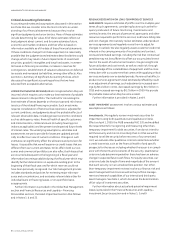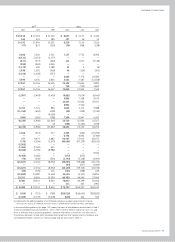GE 2011 Annual Report Download - page 68
Download and view the complete annual report
Please find page 68 of the 2011 GE annual report below. You can navigate through the pages in the report by either clicking on the pages listed below, or by using the keyword search tool below to find specific information within the annual report.’
66 GE 2011 ANNUAL REPORT
Compared to the market approach, the income approach
more closely aligns each reporting unit valuation to our business
profi le, including geographic markets served and product offer-
ings. Required rates of return, along with uncertainty inherent
in the forecasts of future cash fl ows, are refl ected in the selec-
tion of the discount rate. Equally important, under this approach,
reasonably likely scenarios and associated sensitivities can be
developed for alternative future states that may not be refl ected
in an observable market price. A market approach allows for
comparison to actual market transactions and multiples. It can
be somewhat more limited in its application because the popula-
tion of potential comparables is often limited to publicly-traded
companies where the characteristics of the comparative business
and ours can be signifi cantly different, market data is usually not
available for divisions within larger conglomerates or non-public
subsidiaries that could otherwise qualify as comparable, and the
specifi c circumstances surrounding a market transaction (e.g.,
synergies between the parties, terms and conditions of the trans-
action, etc.) may be different or irrelevant with respect to our
business. It can also be diffi cult, under certain market conditions,
to identify orderly transactions between market participants in
similar businesses. We assess the valuation methodology based
upon the relevance and availability of the data at the time we per-
form the valuation and weight the methodologies appropriately.
Estimating the fair value of reporting units requires the use of
estimates and signifi cant judgments that are based on a number
of factors including actual operating results. If current conditions
persist longer or deteriorate further than expected, it is reason-
ably possible that the judgments and estimates described above
could change in future periods.
We review identifi ed intangible assets with defi ned use-
ful lives and subject to amortization for impairment whenever
events or changes in circumstances indicate that the related car-
rying amounts may not be recoverable. Determining whether
an impairment loss occurred requires comparing the carrying
amount to the sum of undiscounted cash fl ows expected to be
generated by the asset. We test intangible assets with indefi nite
lives annually for impairment using a fair value method such as
discounted cash fl ows. For our insurance activities remaining in
continuing operations, we periodically test for impairment our
deferred acquisition costs and present value of future profi ts.
Further information is provided in the Financial Resources and
Liquidity—Goodwill and Other Intangible Assets section and in
Notes 1 and 8.
PENSION ASSUMPTIONS are signifi cant inputs to the actuarial mod-
els that measure pension benefi t obligations and related effects on
operations. Two assumptions—discount rate and expected return
on assets—are important elements of plan expense and asset/
liability measurement. We evaluate these critical assumptions at
least annually on a plan and country-specifi c basis. We periodically
evaluate other assumptions involving demographic factors, such
as retirement age, mortality and turnover, and update them to
refl ect our experience and expectations for the future. Actual
results in any given year will often differ from actuarial assump-
tions because of economic and other factors.
Accumulated and projected benefi t obligations are measured
as the present value of expected payments. We discount those
cash payments using the weighted average of market-observed
yields for high-quality fi xed-income securities with maturities
that correspond to the payment of benefi ts. Lower discount rates
increase present values and subsequent-year pension expense;
higher discount rates decrease present values and subsequent-
year pension expense.
Our discount rates for principal pension plans at December 31,
2011, 2010 and 2009 were 4.21%, 5.28% and 5.78%, respectively,
refl ecting market interest rates.
To determine the expected long-term rate of return on pension
plan assets, we consider current and expected asset allocations,
as well as historical and expected returns on various categories
of plan assets. In developing future long-term return expecta-
tions for our principal benefi t plans’ assets, we formulate views
on the future economic environment, both in the U.S. and abroad.
We evaluate general market trends and historical relationships
among a number of key variables that impact asset class returns
such as expected earnings growth, infl ation, valuations, yields and
spreads, using both internal and external sources. We also take
into account expected volatility by asset class and diversifi cation
across classes to determine expected overall portfolio results
given current and expected allocations. Asset earnings in our
principal pension plans were fl at in 2011, and had average annual
earnings of 4.7%, 6.7% and 8.7% per year in the 10-, 15- and
25-year periods ended December 31, 2011, respectively. These
average historical returns were signifi cantly affected by invest-
ment losses in 2008. Based on our analysis of future expectations
of asset performance, past return results, and our current and
expected asset allocations, we have assumed an 8.0% long-term
expected return on those assets for cost recognition in 2012 com-
pared to 8.0% in 2011 and 8.5% in both 2010 and 2009.
Changes in key assumptions for our principal pension plans
would have the following effects.
• Discount rate—A 25 basis point increase in discount rate
would decrease pension cost in the following year by $0.2 bil-
lion and would decrease the pension benefi t obligation at
year-end by about $1.9 billion.
• Expected return on assets—A 50 basis point decrease in the
expected return on assets would increase pension cost in the
following year by $0.2 billion.
Further information on our pension plans is provided in the
Operations—Overview section and in Note 12.
INCOME TAXES. Our annual tax rate is based on our income, statu-
tory tax rates and tax planning opportunities available to us in the
various jurisdictions in which we operate. Tax laws are complex and
subject to different interpretations by the taxpayer and respective
governmental taxing authorities. Signifi cant judgment is required
in determining our tax expense and in evaluating our tax positions,
including evaluating uncertainties. We review our tax positions
quarterly and adjust the balances as new information becomes
available. Our income tax rate is signifi cantly affected by the tax
rate on our global operations. In addition to local country tax laws
and regulations, this rate depends on the extent earnings are
























